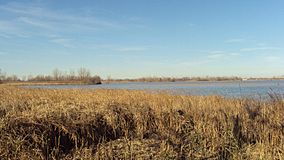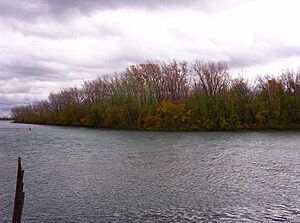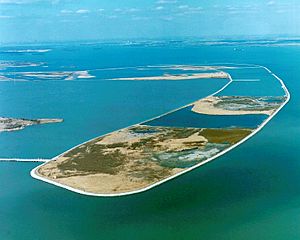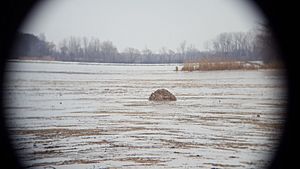Detroit River International Wildlife Refuge facts for kids
Quick facts for kids Detroit RiverInternational Wildlife Refuge |
|
|---|---|
|
IUCN Category IV (Habitat/Species Management Area)
|
|

North Maumee Bay Archeological District
|
|
| Location | Detroit River / West Lake Erie |
| Area | 5,868.09 acres (23.7473 km2) |
| Established | December 21, 2001 |
| Governing body | |
The Detroit River International Wildlife Refuge is a special place for animals. It is the only international wildlife refuge in all of North America. This means it is protected by both the United States and Canada.
The refuge was created in 2001. It is managed by the United States Fish and Wildlife Service and the Canadian Wildlife Service. Even though it is in a big city area, it protects important natural spaces. The refuge covers about 7.88 square miles (20.42 km2). It includes wetlands, islands in the Detroit River, and waterfront parks. It stretches along 48 miles (77 km) of the Detroit River and Western Lake Erie shoreline. A very important part of the refuge is Humbug Marsh. This wetland is recognized as important around the world.
Contents
History of the Refuge
Pollution Problems in the Past
For many years, the land around the Detroit River was very busy with factories. These factories often dumped chemicals and waste into the river. This caused a lot of water pollution. Garbage and sewage from the growing city of Detroit also ended up in the river.
Because of this, the Detroit River became very polluted. It was unsafe for people to swim or fish there. The pollution was especially bad where the river met Lake Erie. Every year, thousands of migrating birds died from oil slicks and dirty water. There was so little oxygen in the river that fish could not live there. Parts of Lake Erie were also very polluted. People even called parts of the lake "dead" because nothing could survive.
Early Steps to Clean Up
In 1961, a smaller protected area was created. It was called the Wyandotte National Wildlife Refuge. This was thanks to a politician named John Lesinski, Jr.. This refuge helped bring in rules for factories. It also provided money to start cleaning the river.
However, many businesses in Detroit did not want to clean up the river. They worried it would hurt their factories and the economy. In 1970, fishing had to stop in the Detroit River and nearby lakes. This was because dangerous levels of mercury were found in the water. This caused many people who fished for a living to lose money. This event made people realize how serious the pollution was. It led to a huge effort to clean up the river. For a long time, cleaning efforts were difficult because they cost so much money. Also, factories had a lot of power and did not want new rules. The Wyandotte refuge was very small. It could not stop an area called Grassy Island from becoming very polluted.
Creating the International Refuge
In 2001, the small Wyandotte refuge became part of a much larger one. This new area was the Detroit River International Wildlife Refuge. A politician named John Dingell strongly supported its creation. President George W. Bush officially signed it into law on December 21, 2001.
Since then, millions of dollars have been spent to buy land and improve the environment. The Detroit River has been cleaned up a lot. Many native animals are now returning to the area. Some of these animals are endangered species. Bald eagles, ospreys, and peregrine falcons are now seen there. Fish like lake whitefish, sturgeon, and salmon are also coming back. Many different kinds of mammals live along the coast.
The refuge is a very important stop for migrating birds. Over 30 types of waterfowl and 17 types of raptors use this area. There are also 31 types of shorebirds and 160 types of songbirds. About 117 types of fish live in or travel through the Detroit River.
Current Area of the Refuge

When it first started, the Detroit River International Wildlife Refuge only included areas from the old Wyandotte refuge. This was about 304 acres (123 ha) around Grassy Island and Mamajuda Island. Soon after, Mud Island was given to the refuge.
The refuge kept growing by buying more land. Calf Island was added in 2002. In 2003, the United States Fish and Wildlife Service made an agreement with DTE Energy. This agreement added parts of their land to the refuge. These areas were near the Enrico Fermi Nuclear Generating Station. This was the first time the refuge expanded into Monroe County along Lake Erie. Other areas in Lake Erie, reaching almost to the Michigan–Ohio border, were also added. Many of these lands are managed together with their owners.
In 2004, the refuge grew to include Humbug Marsh and Humbug Island. It also added the Strong Unit, which is north of Estral Beach. In 2005, the refuge started managing the 243-acre (98 ha) Eagle Island Marsh in Monroe, Michigan. This area was once very polluted. It is at the mouth of the River Raisin.
In 2006, the refuge added the 780-acre (315 ha) Lake Erie Metropark. With the addition of the Erie Marsh in 2006, the refuge doubled in size. It now included wetlands near the Ohio border, like Gard Island. This was a big step for the refuge. It grew from 304 acres in 2001 to 5,047 acres (2,042 ha) by 2007. The last area added was called Howard Fix, which is 65 acres (26 ha).
The refuge also owns the shallow areas around these islands. It works with the United States Army Corps of Engineers and Detroit Edison. They manage hundreds of acres of habitat on Lake Erie together. Several existing parks are also within the refuge's boundaries. These include Elizabeth Park, Sterling State Park, and Lake Erie Metropark.
The main office for the Detroit River International Wildlife Refuge is in Grosse Ile Township. This area is not officially part of the refuge itself. In Canada, the refuge does not have official boundaries. No Canadian parts of the Detroit River or Lake Erie are formally included. All current and future land for the refuge is in the United States. It is managed by the U.S. Fish and Wildlife Service.
Future Plans for Expansion

The Detroit River International Wildlife Refuge currently covers about 7.88 square miles (20.42 km2). This land is spread out along the west coast of the Detroit River and Lake Erie. However, the United States Department of the Interior has approved plans for the refuge to grow much larger. They want to add up to 18.75 square miles (48.56 km2) of land and water.
Expanding the refuge is a top goal. But it is challenging because of money and because most areas are privately owned. Much of the land in the refuge is managed jointly. This means individual landowners and the government work together. The expansion could include areas with many people living there. These include parts of Grosse Ile Township, riverfront communities, and the cities of Berlin and Frenchtown.
The planned expansion stretches for 48 miles (77 km). It goes from the southern border of Detroit all the way to the Michigan–Ohio border. It would not include any areas inside the city of Detroit. Some possible areas to add are Zug Island, Grosse Ile, Elizabeth Park, Pointe Mouillee State Game Area, Sterling State Park, and Turtle Island.
Canada might also add areas to the refuge. These could include Fighting Island, which has already been cleaned up a lot. Other possible Canadian additions are Grass Island, Turkey Island, Crystal Island, and Bois Blanc Island.
Images for kids




